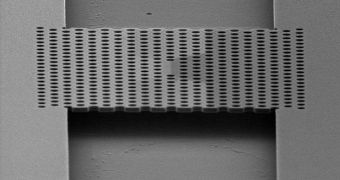A group of engineers from the Stanford University announces the development of an extremely energy-efficient laser, which could potentially be used to revolutionize optical communications systems.
This accomplishment could lead to the development of smaller and faster data transmission technologies, which could bring the future ever closer. The new laser, its creators say, is a lot more efficient and fast than anything on the market today.
Reducing the amount of electricity that goes into electrical circuits is one of the main drives in research today, considering the vast amounts of power that data centers, Internet nodes, supercomputers and company headquarters are consuming.
A lot of money are now invested in research groups going out of their way to develop methods of reducing this level of consumption. Energy efficiency was never a key expression in the electronics industry, as evidenced by current consumption patterns.
But the tiny, highly-efficient semiconductor laser that the Stanford team developed takes that into account as well. The device could soon enable the fast transmission of data without the use of electrons.
For several years now, experts have been trying to make the switch from using electrons to encode data to photons, but that process turned out to be more lengthy and complex than they had imagined.
“Today's electrical data transmission circuits require a lot of energy to transmit a bit of information and are, relatively speaking, slow,” explains Stanford associate professor of electrical engineering Jelena Vuckovic, who is a part of the team working on the new generation of nanoscale lasers.
Details of the new instrument appear in the latest issue of the top scientific journal Nature Photonics.
“We've produced a nanoscale optical data transmitter – a laser – that uses 1,000 times less energy and is 10 times faster than the very best laser technologies in commercial use today,” the expert reveals.
“Better yet, we believe we can improve upon those numbers." Vuckovic says about the photonic-crystal laser. She adds that the new device does not need a secondary laser to pump light in, as other existing models of the same technology do.
“We really needed a laser pumped with electricity, not light,” the researcher explains. The new laser is capable of supporting 100 billion on-off modulations per second. This means that they are 10 times faster than the most advanced data transmitters now in use.
But even further improvements are possible, the team adds. “We can produce a laser that operates at room temperature while maintaining energy efficiency at about 1,000 times less than today's commercial technologies. We can see a light on the horizon,” Vuckovic concludes.

 14 DAY TRIAL //
14 DAY TRIAL //